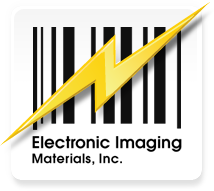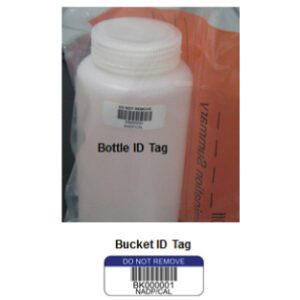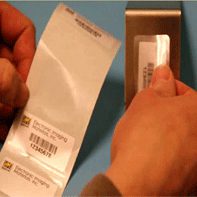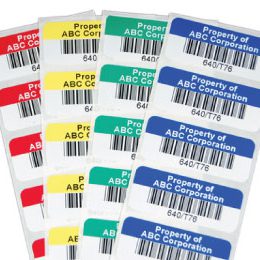You’re in a bustling pharmaceutical lab, where rows of vials line the counters and each test tube is assigned to a critical drug trial. One misstep with a label could mean mixing up active ingredients, jeopardizing weeks or even months of research. Now picture the same scenario in a hospital lab, where the incorrect labeling of a specimen could have life-altering consequences for a patient. In both environments—and countless others—reliable labels are non-negotiable. A single barcode label has the power to keep workflows organized, ensure compliance, and protect human health.
We’ll explore five major industries that depend on laboratory labels for efficiency, compliance, and safety. Understanding each sector’s unique needs will help you appreciate why choosing the right solutions—like those offered by Electronic Imaging Materials—matters. Let’s dive in.

Pharmaceuticals
The pharmaceutical industry sits at the intersection of innovation and rigorous oversight. Drug manufacturers must adhere to strict protocols, from initial research to mass production. Pharmaceutical labels thus serve more than a simple organizational function; they are a critical component of compliance with agencies like the U.S. Food and Drug Administration (FDA).
- Drug Trials: Experimental compounds need precise labeling to ensure accurate dosage and data tracking.
- Manufacturing & Packaging: Each bottle or blister pack must display batch numbers, expiration dates, and safety warnings.
- Traceability & Recall Management: A properly formatted barcode label can streamline recalls by identifying which batches or lots might be affected.
Because the stakes are so high, pharmaceutical companies cannot afford mislabeled samples. A single error can lead to regulatory scrutiny or put patient health at risk. This reality underscores the need for robust labeling solutions—reliable adhesive, durable materials, and print quality that remains crisp throughout the life of the product.
Compliance and Destruction of Ribbons
In pharmaceutical environments, information security can be as important as the product itself. Printing ribbons used in thermal transfer printing may retain a “reverse image” of the data. Destroying these ribbons becomes necessary to comply with privacy regulations or proprietary data protection guidelines. Pharmaceutical labs frequently require protocols ensuring ribbons are either securely disposed of or properly destroyed to prevent data leaks.
Biotechnology
Biotechnology spans gene therapy, cell culture, and innovative cancer treatments—fields that are rapidly evolving and often involve highly sensitive processes. Whether you’re developing new biologics or studying cellular pathways, you’ll need labeling solutions that can withstand everything from liquid nitrogen storage to repeated freeze-thaw cycles.
- Cryogenic Research: Samples stored at -196°C demand specialized adhesives that won’t fail at ultra-low temperatures.
- Cell & Tissue Culture: Tubes and plates get handled repeatedly, requiring smudge-proof labels that remain legible even when exposed to moisture or chemicals.
- Advanced Data Tracking: Barcode scanning often integrates directly with Laboratory Information Management Systems (LIMS), automating data entry to reduce errors.
Specialty labels are essential for biotech labs because standard office or shipping labels simply cannot tolerate rigorous conditions. These labs operate at the cutting edge of science, so their labeling must keep pace.
Customization for Unique Protocols
Biotech researchers often employ unique protocols or specialized equipment. Custom-sized labels and adhesive formulations help ensure a perfect fit for the vials, slides, and plates used in cutting-edge experiments. Color coding or specialized printing can also help segregate different project phases or research categories, boosting lab efficiency.
Healthcare Settings
Mislabeling can have dire consequences in hospitals, clinics, and diagnostic labs. A mislabeled blood sample could result in a misdiagnosis, while an improperly marked tissue specimen might lead to incorrect treatments. The healthcare sector leans heavily on barcode label technology to reduce human error and improve patient outcomes.

- Specimen Labeling: Each sample must be tied to the correct patient record, especially in high-volume settings like emergency rooms or testing labs.
- Medication Administration: Barcodes on syringes or IV bags help nurses verify the correct patient, drug, and dosage.
- HIPAA Compliance: Patient data is safeguarded by law. As with pharmaceutical industries, hospitals must ensure that ribbons or other media containing sensitive info are destroyed.
In healthcare, labeling systems also play a role in infection control. Clear, moisture-resistant labels can accompany samples from bedside to lab, ensuring that data remains intact even if exposed to disinfectants or bodily fluids. This level of durability gives healthcare professionals the confidence to focus on patient care rather than administrative headaches.
A Note on Applications
Healthcare facilities often house an array of sample types: blood, tissue, urine, or even swabs for viral testing. Each demands a unique environment—refrigerated, room temperature, or transported in dry ice. A single universal label might not cut it, which is why EIM and other experts provide multiple solutions calibrated for specific conditions.
Environmental Testing
Environmental labs deal with water, soil, air, and chemical samples to gauge pollution, ensure compliance with regulatory standards, or study ecosystems. The process often involves collecting samples off-site, labeling them in sometimes harsh field conditions, and then transporting them to a controlled lab environment. Maintaining a consistent barcode label system across these steps is critical for reliable data.
- Sample Traceability: Each sample can be tied to its geographic origin and collection date, ensuring an accurate chain of custody.
- Regulatory Compliance: Government agencies often set strict guidelines for sample labeling, handling, and reporting.
- Varied Storage Conditions: Some samples might be refrigerated, while others remain at room temperature. Labels must stick and remain readable across these conditions.
Because environmental testing can influence public health decisions—like the safety of drinking water or pollutant levels in local soil—there’s no room for guesswork. A clear, legible label ensures that each sample’s data is accurately captured and reported.
Rugged Durability for Fieldwork
Environmental labs occasionally conduct on-site testing in remote or outdoorsy settings. A label that quickly peels off when exposed to rain, mud, or temperature swings can ruin an entire batch of samples. That’s why durable adhesives, weather-resistant materials, and fade-proof inks are so important in this line of work.
Academic and Research Institutions
Colleges, universities, and dedicated research institutions are hubs of innovation. From undergraduate labs running basic experiments to high-level research teams investigating quantum physics or gene editing, these settings host a wide variety of sample types and experimental workflows. Accurate labeling is a key component of scientific rigor; mislabeled items can skew data or invalidate months of work.
- Student Labs: Teaching labs introduce future scientists to foundational practices, including the significance of proper labeling.
- Large-Scale Research Projects: Postgraduate and faculty-level work may require tens of thousands of labeled samples, each needing a distinct identifier.
- Equipment and Inventory Labeling: Beyond test tubes and Petri dishes, academic labs label equipment to keep track of usage, maintenance schedules, and departmental ownership.
A reliable barcode label system can significantly simplify these processes. Barcode scanning can integrate directly with campus-wide management systems, automatically updating inventory or research notes.
Collaboration and Publication
In academia, collaboration often stretches across labs, departments, or even different universities. Consistent labeling practices make it easier to share data, replicate experiments, and verify findings. When studies are published or peer-reviewed, thorough documentation—supported by correct labeling—helps ensure the research stands up to scrutiny.
If you see your industry on this list—or if you have equally stringent labeling demands—why settle for off-the-shelf solutions? Explore how Electronic Imaging Materials’ range of barcode label products can be tailored to your specific environment.
How Labeling Requirements Differ Across Industries
You might be wondering if compliance rules vary wildly across these sectors. While each industry has unique protocols—pharmaceutical labs follow FDA regulations while healthcare must also address HIPAA confidentiality—the underlying need for reliable labeling is the same. In many cases, the real differences lie in applications rather than drastically different standards.
- Pharmaceutical vs. Biotechnology: Both often require pharmaceutical labels that can handle sterile environments and strict batch tracking, though biotech might place extra emphasis on cryogenic conditions.
- Healthcare vs. Research Institutions: HIPAA might govern how patient information is stored and destroyed, but data accuracy is essential in both settings.
- Environmental Testing vs. Pharmaceuticals: Both need traceability but may store samples under contrasting temperature and humidity conditions.
The destruction of printing ribbons remains a consideration across many sectors as well. Since ribbons bear a reverse image of everything printed, these can pose a security risk if not disposed of properly. Healthcare labs must abide by HIPAA rules, ensuring that confidential patient data doesn’t wind up in the wrong hands. Pharmaceutical companies, too, want to protect proprietary drug information from being leaked.
Empower Your Industry With EIM
No matter which industry you operate in—pharmaceuticals, biotechnology, healthcare, environmental testing, or academic research—EIM is here to help you find the perfect labeling solution. After all, a reliable barcode label is more than a piece of paper; it’s a lifeline that ensures every sample, product, or specimen maintains its integrity from start to finish.
Ready to transform your labeling process? Contact us to discuss how our proven labeling solutions can meet your specific needs. Make no mistake: the quality of your labels directly impacts the quality of your operations.





